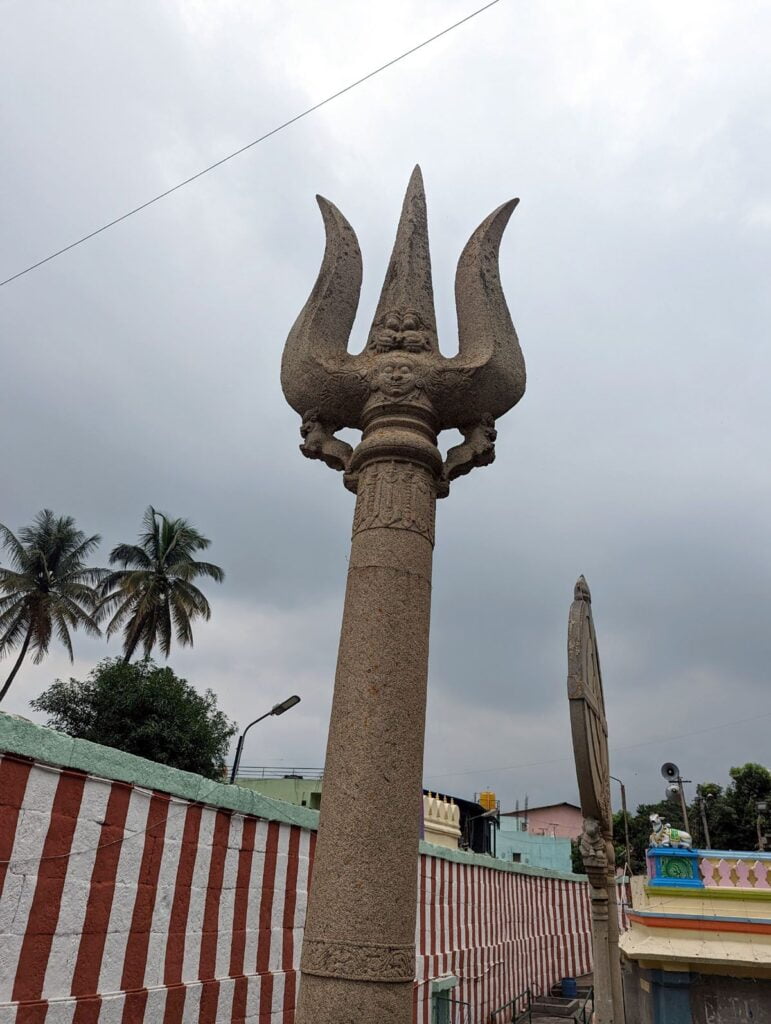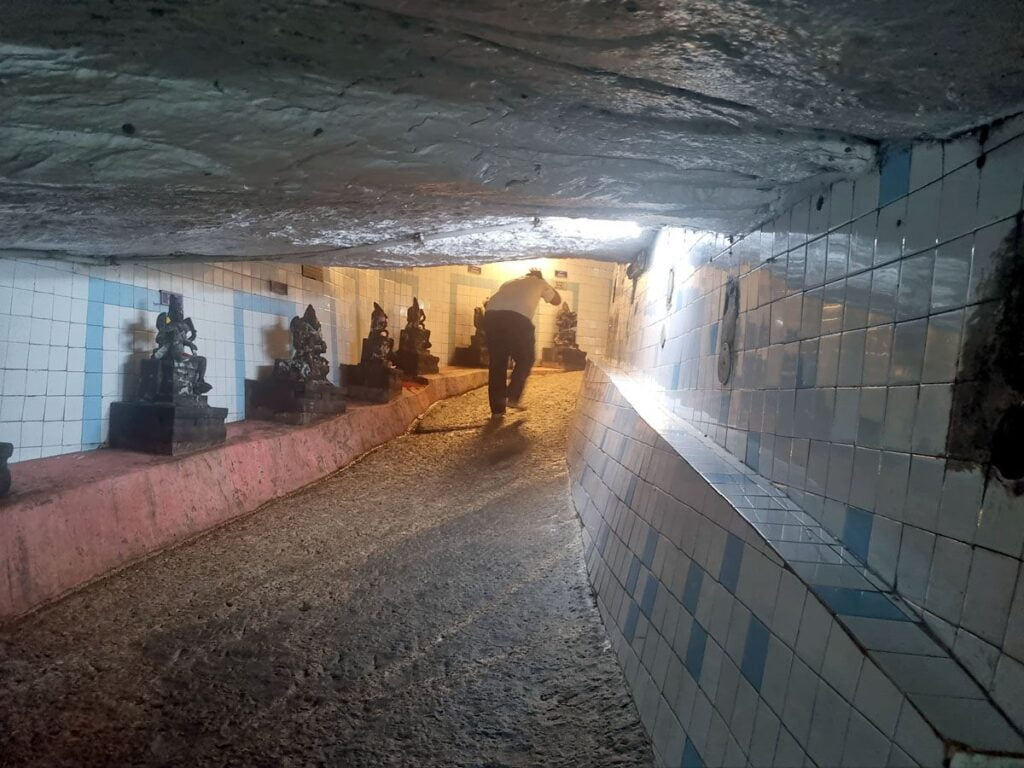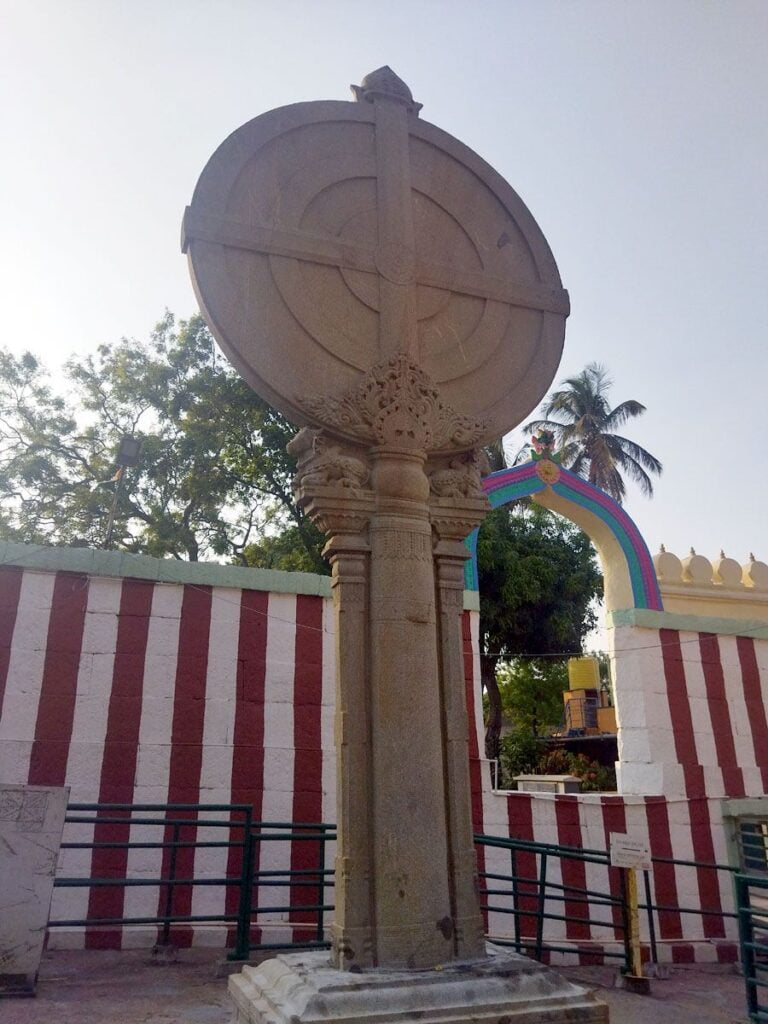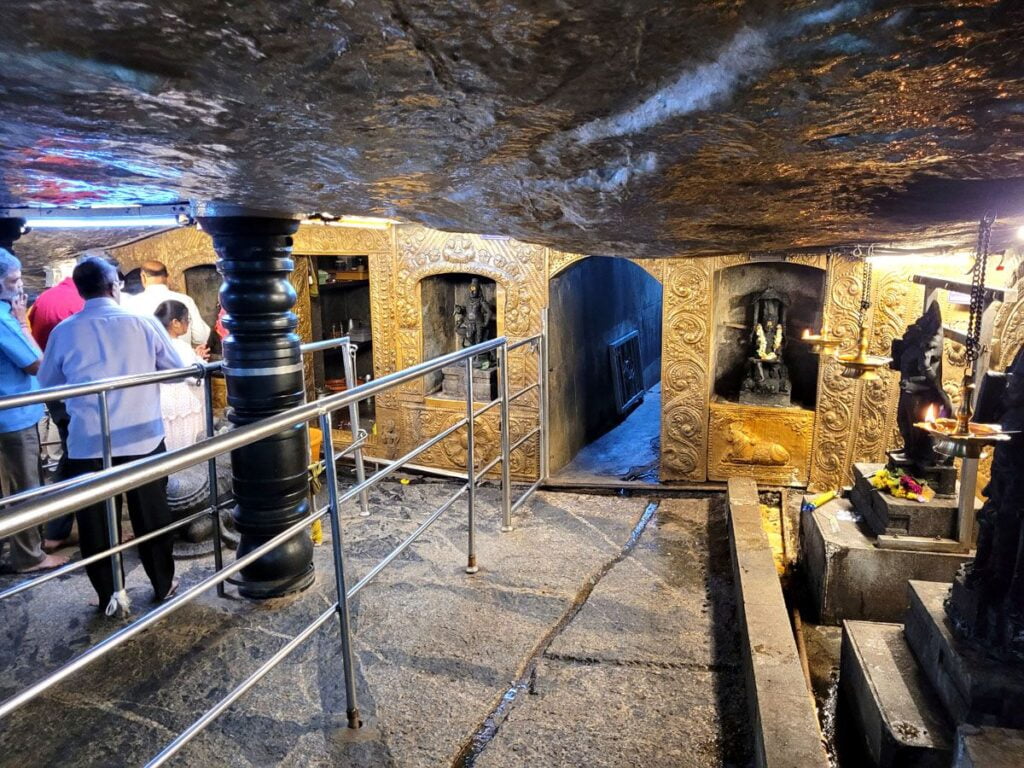Gavi Gangadhareswara Temple Karnataka
The Gavi Gangadhareswara Temple is a Hindu temple dedicated to Shiva located in the Gavipuram neighborhood of Bengaluru, Karnataka, India. It is one of the oldest temples in Bengaluru and is believed to have been built in the Vedic period by Gautama Maharshi and Bharadwaja Muni. The temple was later renovated in the 16th century by Kempe Gowda, the founder of Bengaluru.

Contents
- 1 History of Gavi Gangadhareswara Temple:
- 2 Legend of Gavi Gangadhareswara Temple:
- 3 Myths of Gavi Gangadhareswara Temple:
- 4 Significance of Gavi Gangadhareswara Temple:
- 5 Gavi Gangadhareswara Temple Timing and Rituals:
- 6 Places to visit near Gavi Gangadhareswara Temple:
- 7 FAQ:
- 8 How to reach Gavi Gangadhareswara Temple:
- 9 Google Maps:
History of Gavi Gangadhareswara Temple:
The temple’s history unfolds like a captivating saga. While some believe its origins trace back to the Vedic period, with sages Gautama Maharshi and Bharadwaja Muni carving it out of a rock, most accounts credit its current form to the 16th century. Kempe Gowda I, the revered founder of Bangalore, is said to have renovated and expanded the temple after being released from a five-year imprisonment. This act of gratitude transformed the Gavi Gangadhareswara Temple into a symbol of resilience and faith.
Stepping into the temple’s courtyard, one is immediately struck by its unique architectural blend. Carved directly into a granite hillside, the temple exhibits the grandeur of Indian rock-cut architecture. Intricate carvings, towering pillars, and serene sculptures transport visitors to a bygone era of artistic finesse.
But the Gavi Gangadhareswara Temple holds mysteries beyond its captivating beauty. Two towering stone discs, known as Suryapana and Chandrapana, stand sentinel in the forecourt. On the auspicious day of Makara Sankranti (January 14th), a celestial phenomenon unfolds. The first rays of the rising sun pierce through a gap between the discs, illuminating the inner sanctum of the temple with a divine glow. This annual spectacle, known as Surya Majjana (sunlight bath), continues to awe devotees and scientists alike.
Within the temple, the sanctum sanctorum houses a captivating murti (idol) of Lord Shiva, adorned with the holy river Ganga flowing from his head. This embodiment of Shiva as Gavi Gangadhareswara, meaning “Lord of the Ganga adorned with a cave,” lends the temple its distinct name.
The Gavi Gangadhareswara Temple is more than just a historical and architectural marvel. It is a vibrant spiritual hub, pulsating with the devotion of countless pilgrims. The temple complex also houses shrines dedicated to Goddess Parvati, Ganesha, Subramanya, and Angimurthi Deva, offering a confluence of divine energies.
Read More>> Kotilingeshwara Temple Karnataka: 108 Ft Massive Lingam in the world

Legend of Gavi Gangadhareswara Temple:
A Tapestry of Tales:
The temple’s origin weaves a tapestry of two captivating legends. One whispers of sages, claiming that Gautama Maharshi and Bharadwaja Muni meditated within its cave-like confines during the Vedic period. The other tale, etched in the hearts of Bangaloreans, speaks of Kempe Gowda I, the city’s founder. Imprisoned for five years by Rama Raya, upon his release, Kempe Gowda vowed to express his gratitude through a magnificent act of devotion. Legend has it that the Gavi Gangadhareswara Temple stands as a testament to his fulfilled promise.
Carved from Devotion:
Hewn from a monolithic rock, the temple’s architecture stuns with its intricate carvings and sheer audacity. Sunlight streams through strategically placed openings, bathing the sanctum in a celestial glow during specific times of the year. On Makara Sankranti, the day marking the Sun’s northward movement, a beam of light illuminates the Shiva linga, a phenomenon believed to herald auspicious beginnings.
Whispers of Mystery:
The temple’s mystique extends beyond its architecture. The enigmatic stone discs in the forecourt, their purpose shrouded in time, fuel whispers of astronomical alignments and forgotten rituals. Tales speak of hidden tunnels, one supposedly leading to the holy city of Varanasi, the other to a Shiva temple atop Shivagange Hill.
A Beacon of Faith:
Beyond the legends, the Gavi Gangadhareswara Temple remains a vibrant center of faith. Devotees flock to seek blessings from the presiding deity, Lord Shiva, and bathe in the sacred waters of the Gautama Theertha, a natural spring within the temple complex.
Visiting the Legend:
If you seek a glimpse into Bangalore’s ancient soul, the Gavi Gangadhareswara Temple beckons. Witness the sun’s ethereal dance on the Shiva linga, marvel at the rock-cut artistry, and lose yourself in the whispers of legend. The temple stands not just as a testament to faith and architectural brilliance, but as a reminder of the enduring power of stories that bind us to our past and guide us towards a luminous future.
Read More>> Shri Kalabhairaveshwara Temple Bengaluru

Myths of Gavi Gangadhareswara Temple:
1. The Entrapment of the Ganges:
The temple’s name itself holds a mythical key. “Gavi” translates to “cave,” while “Gangadhareswara” signifies “Lord Shiva who holds the Ganges.” Legend has it that the holy river Ganges, personified as a celestial maiden, descended from heaven to appease Shiva’s wrath. However, she became entangled in his matted locks, unable to return to the earthly realm. To pacify her, Shiva allowed a small stream of the Ganges to flow from his hair, giving birth to the Arkavathi River that flows near the temple. This mythical confluence is believed to imbue the temple with immense spiritual power.
2. The Tunnels of Time and Space:
Whispers swirl around the existence of two secret tunnels emanating from the temple’s inner sanctum. One, it is said, leads all the way to Varanasi, the holy city on the banks of the Ganges, thousands of miles away. The other supposedly connects to another Shiva temple, the Gangadhareshwara temple, perched atop the Shivagange hill, about 10 miles from Gavi Gangadhareswara. These mythical tunnels represent not just physical connections, but also the spiritual pathways traversing time and space, connecting devotees to sacred destinations and divine energies.
3. The Healing Touch of Agni:
Within the temple complex lies a shrine dedicated to Agni, the Hindu god of fire. Devotees fervently believe that seeking blessings from Agni here can cure all ailments related to the eyes. This belief stems from the myth of Agni’s purifying flames holding the power to cleanse and heal. Offering prayers and performing rituals at the Agni shrine is a common practice among those seeking divine intervention for eye-related problems.
4. Kempegowda’s Devotion:
The Gavi Gangadhareswara Temple holds a special significance for Bangalore, as it is attributed to the city’s founder, Kempegowda I. Legend has it that Kempegowda was once imprisoned by a rival king. During his five-year captivity, he prayed fervently to Lord Shiva, vowing to build a magnificent temple upon his release. True to his word, upon regaining freedom, Kempegowda embarked on the expansion and beautification of the Gavi Gangadhareswara Temple, transforming it into the architectural gem it is today.
5. The Celestial Alignment:
The temple exhibits a remarkable celestial alignment. Built in the Vijayanagara style, its architecture is oriented in such a way that the first rays of the sun on Makar Sankranti (the winter solstice) illuminate the inner sanctum of the Shiva lingam. This phenomenon, known as “Surya Majjana,” is believed to be a blessing from the sun god and signifies the union of the divine with the earthly realm.
Read More>> 7th Century Virupaksha Temple Hampi

Significance of Gavi Gangadhareswara Temple:
Historical Significance:
- One of the oldest temples in Bangalore: Believed to have been built by Gautama Maharshi and Bharadwaja Muni in the Vedic period, the temple was later renovated in the 16th century by Kempe Gowda I, the founder of Bangalore. This makes it a valuable piece of the city’s historical tapestry.
- A testament to architectural prowess: The temple showcases exquisite examples of Indian rock-cut architecture. The cave sanctum with intricate carvings and monolithic pillars stands as a testament to the skill and dedication of ancient artisans.
Religious Significance:
- Dedicated to Lord Shiva: The temple is primarily dedicated to Lord Shiva, one of the principal deities in Hinduism. Devotees from all over India visit the temple to seek blessings and offer prayers.
- Unique alignment with celestial bodies: The temple’s design incorporates precise astronomical calculations. During Makar Sankranti (January 14th), the first rays of the Sun illuminate the Shivalinga inside the cave for a brief period, creating a mesmerizing spectacle. This alignment signifies the divine connection between the temple and the cosmos.
Cultural Significance:
- A vibrant center of festivals and rituals: The temple hosts various Hindu festivals throughout the year, including Makar Sankranti, Mahashivaratri, and Kartik Purnima. These festivals draw large crowds and are celebrated with traditional fervor.
- Symbol of resilience and community: The temple has survived centuries of political and social upheavals. It stands as a symbol of the city’s rich cultural heritage and the enduring faith of its people.
Read More>> Hasanamba Temple: Stone Sleeps & Spirit Awakes
Gavi Gangadhareswara Temple Timing and Rituals:
Timings:
- General Darshan: The temple is open for darshan (viewing the deity) every day from 6:00 AM to 12:30 PM and again from 5:00 PM to 8:00 PM.
- Special Timings: During specific festivals like Makar Sankranti and Shivaratri, the temple timings may change. It’s best to check the temple website or local sources for updated information during these times.
Rituals:
- Abhisheka: This ritual involves pouring sacred liquids like milk, honey, and panchamrita (five nectars) over the Shiva Linga, the symbolic representation of Lord Shiva. Abhishekas are performed daily at specific times, and devotees can participate by offering these liquids.
- Archana: This offering involves chanting hymns and mantras dedicated to Lord Shiva while holding betel leaves, flowers, and fruits. Archana can be performed by devotees themselves or by priests on their behalf.
- Darshan: Simply viewing the Shiva Linga with utmost devotion and respect is also considered a powerful form of worship. Devotees often queue up for darshan during peak hours.
- Special Rituals: Certain unique rituals are performed at the Gavi Gangadhareshwara Temple:
- Surya Majjana: This remarkable event occurs around January 14th each year, when the sun’s rays pass through the horns of the Nandi bull statue and directly illuminate the Shiva Linga inside the sanctum. The timing of this event aligns with Makar Sankranti, a major Hindu festival, making it even more special.
- Deepotsava: During the Deepavali festival, the temple is adorned with thousands of oil lamps, creating a mesmerizing spectacle.
Read More>> Murudeshwar Temple Karnataka: India’s 2nd Massive Shiva Statue

Places to visit near Gavi Gangadhareswara Temple:
- Lalbagh Botanical Garden:
- Lalbagh is one of the most famous botanical gardens in Bangalore. It is home to a variety of plants, flowers, and trees. The Glass House inside the garden is a major attraction.
- Tipu Sultan’s Summer Palace:
- Located in the heart of Bangalore, this palace was the summer residence of Tipu Sultan, the ruler of Mysore. It showcases Indo-Islamic architecture and historical artifacts.
- Bull Temple (Nandi Temple):
- Just a short distance from Gavi Gangadhareswara Temple, the Bull Temple is dedicated to Nandi, the sacred bull of Lord Shiva. The huge Nandi idol is carved from a single granite rock.
- Bugle Rock Park:
- This park is known for its unusual rock formations and offers a peaceful environment for a leisurely stroll. The Kempegowda Tower inside the park provides panoramic views of the city.
- Dodda Ganapathi Temple:
- Situated near Bull Temple, Dodda Ganapathi Temple houses a giant Ganesha idol. The idol is believed to be one of the oldest and largest Ganesha statues in Bangalore.
- Visvesvaraya Industrial and Technological Museum:
- A great place for science enthusiasts, this museum showcases various exhibits related to science, engineering, and technology. It’s an engaging and educational experience.
- ISKCON Temple Bangalore:
- The ISKCON Temple is a renowned spiritual and cultural complex. It features a beautifully constructed temple, cultural exhibits, and a vegetarian restaurant.
- Bangalore Fort:
- Although much of the fort is in ruins, it has historical significance. Tipu Sultan’s Summer Palace is located within the fort complex.
- Cubbon Park:
- A large public park in the heart of Bangalore, Cubbon Park is known for its lush greenery, walking paths, and various statues and buildings, including the State Central Library.
- Vidhana Soudha:
- This iconic building houses the state legislature of Karnataka. It is a magnificent example of neo-Dravidian architecture and is beautifully illuminated at night.
Read More>> Sri Siddhivinayak Temple Rejinthal
FAQ:
Where is Gavi Gangadhareswara Temple located?
Gavi Gangadhareswara Temple is located in Bengaluru, Karnataka, India. It is about 10 kilometers from the city center. The temple is easily accessible by public transportation or car.
What is the history of Gavi Gangadhareswara Temple?
The temple is believed to have been built in the Vedic period by Gautama Maharshi and Bharadwaja Muni. It was later renovated in the 16th century by Kempe Gowda I, the founder of Bengaluru.
What is the architecture of Gavi Gangadhareswara Temple?
The temple is a cave temple carved out of a single rock. The main deity is a Shiva Lingam, which is located in the center of the cave. The temple is also home to a number of other deities, including Vishnu, Lakshmi, Ganesha, and Hanuman.
What is the most famous feature of Gavi Gangadhareswara Temple?
The most famous feature of the temple is the sunbeam that falls on the Shiva Lingam on Makar Sankranti, the first day of the sun’s northward journey. This phenomenon is said to be a sign of good luck and prosperity.
What are the visiting hours of Gavi Gangadhareswara Temple?
The temple is open from 6:00 AM to 11:00 AM and 5:30 PM to 8:30 PM.
What are the entry fees for Gavi Gangadhareswara Temple?
There is no entry fee for the temple.
What are some other nearby attractions?
Some other nearby attractions include the Lalbagh Botanical Garden, the HAL Aerospace Museum, and the Vidhana Soudha.
How to reach Gavi Gangadhareswara Temple:
By Air:
- The nearest airport is Kempegowda International Airport (BLR), located about 40 kilometers from the temple. From the airport, you can hire a taxi or use other transportation options to reach Gavi Gangadhareswara Temple.
By Train:
- The nearest railway station is Bangalore City Junction. From the railway station, you can hire a taxi, take a bus, or use the metro to reach the Gavi Gangadhareswara Temple.
By Metro:
- The Gavi Gangadhareswara Temple is accessible by the Namma Metro. The nearest metro station is the National College Metro Station. From there, you can take a taxi or walk to the temple.
By Bus:
- Bangalore has a well-connected bus network, and there are buses that ply to Gavipuram Guttahalli. You can check with local bus authorities for routes that pass near the temple.

One Comment